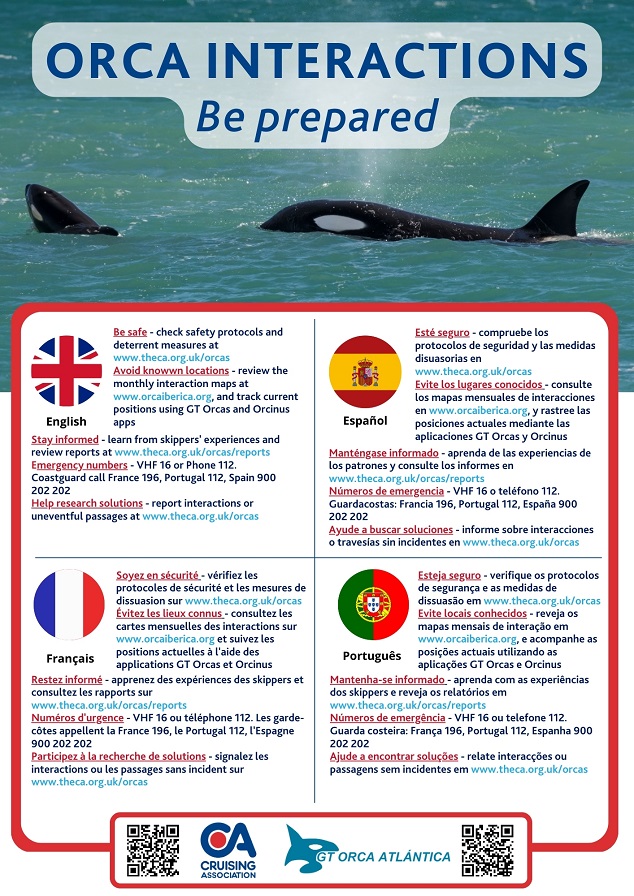Orca Interaction Safety Guide
Collaborators: Cruising Association (CA) and
Grupo de Trabajo Orca Atlántica (GTOA)
Introduction
Since 2020, some orca who frequent the Atlantic coasts of Spain and Portugal have been damaging yachts in the seas between the north of the Bay of Biscay and into the Mediterranean Sea as far as Marbella in southern Spain.
Around 15 of this population of less than 50 individuals have caused damage to 100s of small vessels, at least 7 of which have sunk. The damage typically affects the rudders and crews can usually make their way to a safe port but many have required assistance from rescue services. After several years of study, scientists are still uncertain why the orca are behaving this way, but suspect it may be a form of play.
To date no-one has been seriously injured by the orca. As they solely consume fish and avoid warm-blooded mammals, the primary risk from these interactions lies in damage to yachts and the very real possibility of consequential injury to the crew.
The orca are a protected species, and certain actions taken to deter or drive them off during an interaction which harms them runs the risk of prosecution.
Jump to content
Stay safe
Any crew considering sailing in the affected waters is strongly advised to prepare for the risk of an interaction as they would prepare for adverse weather.
The links below will provide invaluable information when planning to sail in the affected areas:
Preparing for passage
- REVIEW the CA Checklist of Actions
- CONSIDER the CA Monthly/Yearly Interaction Location table when planning a passage to review the peak interaction periods in different Zones of the affected area. This table is based on the monthly interaction maps provided by GTOA on their website which can be viewed here.
- STUDY CONVERSATIONS on dedicated community and Facebook groups to learn from those groups, but consider differing views with due caution.
- FAMILIARISE YOURSELF with and keep a note of emergency service contact details provided here
- CONSIDER THE FOLLOWING RISK REDUCTION TIPS
- Depth/Distance offshore
- Antifoul colour
- Autopilot
- Daylight conditions
- REVIEW THE FOLLOWING POTENTIAL DETERRENT MEASURES and prepare your plan for action in the event of and interaction/attack.
- Continued Sailing/Motoring
- Stopping the Boat (playing dead)
- Reversing (when sea state and other conditions allow)
- Other Methods - Noise, Sand, etc
- REVIEW SAFETY PROTOCOLS
In addition to planning to avoid known orca locations, skippers could consider the following factors:
Commentary on these various risk reduction issues can be viewed here.
Note that data relating to these issues obtained from CA interaction reports and uneventful passage reports are contained in the comparative data table
Note that there is no single accepted effective safe and legal deterrent measure. There are conflicting views within scientific groups, government bodies and individual sailors.
The CA cannot advise a skipper on what action to take in the event of an interaction/attack but is gathering reports and information to better understand the problem. The CA provides an Interaction Comments Library in which skippers’ comments from report forms and Facebook groups are collated into the different deterrent measures detailed below. This, together with every detailed report is viewable publicly. The individual reports can be reviewed here.
Commentary on these various possible deterrent measures can be viewed at Continued Sailing/Motoring / Stopping the Boat / Reversing / Other Methods - Noise, Sand, etc
The GTOA scientists and Portuguese Government provide different advice on what actions to take in the event of an interaction/attack than that which is provided by the Spanish Government and Conservación, Información y Estudio sobre Cetáceos (CIRCE). Commentary on each protocol can be found under point 6 above. The Safety Protocol is here.
Note that the CA continues to seek detailed reports from skippers involved in interactions/attacks in order to study the effectiveness of each protocol and presents skippers’ comments collated into different actions. These are presented in the Interaction Comments Library.
When on Passage
- REVIEWthe latest GTOA advisory traffic light maps.
- MONITOR the current interaction reporting app GT Orcas from GTOA available at the Apple Store and on Google Play.
- MONITOR current orca activity on the Facebook and community groups referred to above and detailed here.
- BRIEF crew on your action plan in the event of an interaction before heading out on passage. If your intention is to stop the boat and ‘play dead’, ensure that all crew are aware of the importance of keeping a low profile and minimising interest to orcas.
- KEEP emergency contact details at hand and monitor CH 16
Reporting and Data
The CA requests detailed reports from both interactions and also ‘uneventful passages’ through the affected area during times when interactions are occurring in that area.
These reports take approximately 10 to 15 minutes to complete (depending on the level of detailed comments provided, the remainder of the report forms requiring ‘tick box’ answers).
Every report is anonymised and published on this website, available for study by sailors and scientists alike. The CA uses these reports to prepare the resources provided on this website. The reports are shared with GTOA who use them for their own research purposes.
It is essential that as many reports as possible are received to enable a more detailed picture of the problem and various potential solutions.
Report an Interaction - Share incidents involving orcas.
Report an Uneventful Passage - Report passages without interactions through areas of ongoing interaction activity.
You can view every report in full, along with the comparative data data derived from those reports.





